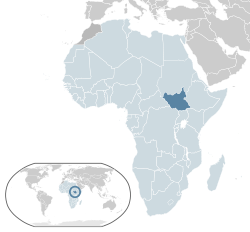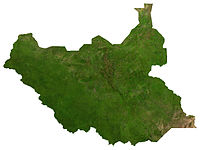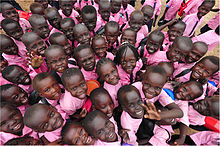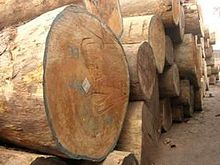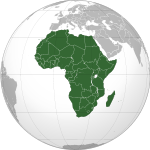- South Sudan
-
"Southern Sudan" redirects here. For the former autonomous regions of Sudan, see Government of Southern Sudan (1972–1983) and Government of Southern Sudan (2005–2011).
Republic of South Sudan 

Flag Coat of arms Motto: "Justice, Liberty, Prosperity" Anthem: "South Sudan Oyee!"
Capital
(and largest city)Juba
04°51′N 31°36′E / 4.85°N 31.6°EOfficial language(s) English[1][2] Recognised national languages All South Sudanese indigenous languages[3] Demonym South Sudanese Government Federal presidential democratic republic - President Salva Kiir Mayardit - Vice President Riek Machar Legislature National Legislature - Upper House Council of States - Lower House National Legislative Assembly Independence from Sudan - Comprehensive Peace Agreement 6 January 2005 - Autonomy 9 July 2005 - Independence 9 July 2011 Area - Total 619,745 km2 (45th)
239,285 sq miPopulation - 2008 census 8,260,490 (disputed)[4] (94th) GDP (nominal) 2011 estimate - Total $13.227 billion [5] - Per capita $1,546 [5] Currency South Sudanese pound ( SSP)Time zone East Africa Time (UTC+3) Drives on the right ISO 3166 code SS Internet TLD .ss[6] (registered but not yet operational) Calling code +211[7] South Sudan (
 i/ˌsaʊθ suːˈdæn/ or /suːˈdɑːn/), officially the Republic of South Sudan,[8] is a landlocked country located in the Sahel region of northeastern Africa.[8] It is also part of the North Africa UN sub-region[9]. Its current capital is Juba, which is also its largest city; the capital city is planned to be moved to the more centrally-located Ramciel in the future.[10] South Sudan is bordered by Ethiopia to the east, Kenya to the southeast, Uganda to the south, the Democratic Republic of the Congo to the southwest, the Central African Republic to the west, and Sudan to the north. South Sudan includes the vast swamp region of the Sudd formed by the White Nile, locally called the Bahr al Jabal.
i/ˌsaʊθ suːˈdæn/ or /suːˈdɑːn/), officially the Republic of South Sudan,[8] is a landlocked country located in the Sahel region of northeastern Africa.[8] It is also part of the North Africa UN sub-region[9]. Its current capital is Juba, which is also its largest city; the capital city is planned to be moved to the more centrally-located Ramciel in the future.[10] South Sudan is bordered by Ethiopia to the east, Kenya to the southeast, Uganda to the south, the Democratic Republic of the Congo to the southwest, the Central African Republic to the west, and Sudan to the north. South Sudan includes the vast swamp region of the Sudd formed by the White Nile, locally called the Bahr al Jabal.The modern states of South Sudan and Sudan were part of Egypt under the Muhammad Ali Dynasty, later being governed as an Anglo-Egyptian condominium until Sudanese independence was achieved in 1956. Following the First Sudanese Civil War, the Southern Sudan Autonomous Region was formed in 1972 and lasted until 1983. A second Sudanese civil war soon developed and ended with the Comprehensive Peace Agreement of 2005. Later that year, southern autonomy was restored when an Autonomous Government of Southern Sudan was formed.
South Sudan became an independent state on 9 July 2011.[11][12] On 14 July 2011, South Sudan became a United Nations member state.[13][14] It joined the African Union on 28 July 2011.[15]
South Sudan is one of the poorest countries with possibly the worst health situation in the world.[16]
Contents
History
Main article: History of South SudanThe Nilotic peoples—the Dinka, Nuer, Shilluk and others—first entered South Sudan sometime before the 10th century. During the period from the 15th century to the 19th century, tribal migrations, largely from the area of Bahr el Ghazal, brought these peoples to their modern locations. The non-Nilotic Azande people, who entered South Sudan in the 16th century, established the region's largest state. The Azande are the third or fourth largest ethnic group in South Sudan (either the Azande or the Bari are third largest). They are found in the Maridi, Yambio, and Tambura districts in the tropical rainforest belt of Western Equatoria and Western Bahr el Ghazal. In the 18th century, the Avungara sib rose to power over the rest of Azande society and this domination continued into the 20th century.[17] Geographical barriers prevented the spread of Islam to the southerners, thus enabling them to retain their social and cultural heritage as well as their political and religious institutions.
 John Garang de Mabior led the Sudan People's Liberation Army until his death in 2005.
John Garang de Mabior led the Sudan People's Liberation Army until his death in 2005.
The Azande have had difficult relations with the neighbours, namely the Moru, Mundu, Pöjulu, and the small groups in Bahr el Ghazal, due to the expansionist policy of their King, Gbudwe, in the 18th century. In the nineteenth century the Azande fought the French, the Belgians and the Mahdists to maintain their independence. Egypt, under the rule of Khedive Isma'il Pasha, first attempted to control the region in the 1870s, establishing the province of Equatoria in the southern portion. Egypt's first governor was Samuel Baker, commissioned in 1869, followed by Charles George Gordon in 1874 and by Emin Pasha in 1878. The Mahdist Revolt of the 1880s destabilised the nascent province, and Equatoria ceased to exist as an Egyptian outpost in 1889. Important settlements in Equatoria included Lado, Gondokoro, Dufile and Wadelai. In 1947, British hopes to join South Sudan with Uganda were dashed by the Juba Conference to unify North and South Sudan.
It is estimated that South Sudan region has a population of 8 million,[18] but given the lack of a census in several decades, this estimate may be severely distorted. The economy is predominantly rural and relies chiefly on subsistence farming.[18] In the middle of the 2000s, the economy began a transition from this rural dominance and urban areas within South Sudan have seen extensive development. The region has been negatively affected by two civil wars since Sudanese independence – the Sudanese government fought the Anyanya rebel army from 1955 to 1972 in the First Sudanese Civil War and then the Sudan People's Liberation Army/Movement (SPLA/M) in the Second Sudanese Civil War for almost twenty-one years after the founding of SPLA/M in 1983 – resulting in serious neglect, lack of infrastructural development, and major destruction and displacement. More than 2.5 million people have been killed, and more than 5 million have become externally displaced while others have been internally displaced, becoming refugees as a result of the civil war and war-related impacts.
A referendum was held from 9 to 15 January 2011 to determine if South Sudan should declare its independence from Sudan, with 98.83% of the population voting for independence. (The results for that referendum were released on 30 January 2011.)[19] Those living in the north and expatriates living overseas also voted.[20] This led to a formal independence on 9 July, although certain disputes still remain such as sharing of the oil revenues as an estimated 80% of the oil in the nation is secured from South Sudan, which would represent amazing economic potential for one of the world's most deprived areas. The region of Abyei still remains disputed and a separate referendum will be held in Abyei on whether they want to join North or South Sudan.[21] The South Kordofan conflict broke out in June 2011 between the Army of Sudan and the SPLA over the Nuba Mountains.
Interethnic warfare that in some cases precedes the war of independence is widespread. Some of these hostilities occurred in Jonglei state, affecting the Murle tribe, and were documented by Human Rights Watch in a 2009 report.[22]
South Sudan is at war with at least seven armed groups in nine of its ten states, with tens of thousands displaced.[23] The fighters accuse the government of plotting to stay in power indefinitely, not fairly representing and supporting all tribal groups while neglecting development in rural areas.[23][24]
Politics
Government
Main article: Politics of South Sudan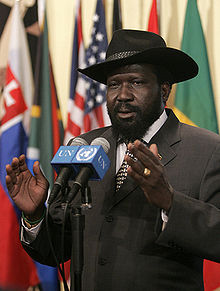 Salva Kiir Mayardit, the first elected President of South Sudan
Salva Kiir Mayardit, the first elected President of South Sudan
The now defunct Southern Sudan Legislative Assembly ratified a Transitional Constitution[25] shortly before independence on 7 July 2011.[26] The Constitution was signed by the President on Independence Day and thereby came into force. This is the supreme law of the land, superseding the Interim Constitution of 2005.[27] The constitution establishes a mixed presidential system of government headed by a President who is Head of State, Head of Government, and Commander-in-Chief of the armed forces. It also established the National Legislature comprising two Houses: a directly elected assembly, the National Legislative Assembly; and a second chamber of representatives of the States, the Council of States. John Garang, the founder of the SPLA/M was the first President of the autonomous government until his death on 30 July 2005. Salva Kiir Mayardit (surname Kiir),[8][28] his deputy, was sworn in as First Vice President of Sudan and President of the Government of Southern Sudan on 11 August 2005. Riek Machar (surname Machar)[8] replaced him as Vice President. Legislative power is vested in the government and the bicameral National Legislature. The Constitution also provides for an independent judiciary, the highest organ being the Supreme Court.
Military
Main article: Armed forces of South SudanA Defense paper was initiated in 2011 by then Minister for SPLA Affairs Majak Agoot Atem, and a draft was produced in 2008. It declared that Southern Sudan would eventually maintain land, air, and riverine forces.[29][30]
Developing state capacity
The post-conflict environment is important to understanding the Government of South Sudan's ability to function and successfully implement its policies. One area in which the Government of South Sudan has had significant success in building its own capacity is developing an integrated system for planning and budget preparation.[31] This has been achieved through the strong and determined leadership of the Ministry of Finance, the strong technical leadership and support of that same ministry and making these goals relevant to local capacity.[31] The results have been that the government has been better able to manage the financial aspects of its functions and projects, and increases in the expertise of its staff in crucial skills, such as basic IT.[31]
National capital project
The capital of South Sudan is located at Juba, which is also the state capital of Central Equatoria and the county seat of the eponymous Juba County, as well as being the country's largest city. However, due to poor infrastructure and massive urban overgrowth in the city, as well as its lack of centrality within South Sudan, the Autonomous Government of Southern Sudan adopted a resolution in February 2011 to study the creation of a new planned city to act as the seat of the government.[32][33] This proposed project is functionally similar to those which resulted in the construction of Abuja, Nigeria; Naypyidaw, Myanmar; and Brasília, Brazil; among other national capitals planned and built in the modern era. It is unclear where the government will come up with funding for the project.
In September 2011, a spokesman for the government said the country's political leaders had accepted a proposal to build a new capital at Ramciel,[34] a place in Lakes state near the borders with Central Equatoria, Eastern Equatoria, and Jonglei. Ramciel is considered to be the geographical center of the country,[35] and the late pro-independence leader John Garang allegedly had plans to relocate the capital there before his death in 2005. The proposal was supported by the Lakes state government and at least one Ramciel tribal chief.[36] The design, planning, and construction of the city will likely take as many as five years, government ministers said, and the move of national institutions to the new capital will be implemented in stages.[34]
States and counties
Main article: States of South SudanSouth Sudan is divided into ten states which correspond to three historical regions of the Sudan: Bahr el Ghazal, Equatoria, and Greater Upper Nile.
- Western Equatoria
- Central Equatoria (containing the national capital city of Juba)
- Eastern Equatoria
- Greater Upper Nile
The ten states are further subdivided into 86 counties.
The Abyei Area, a small region of Sudan bordering on the South Sudanese states of Northern Bahr el Ghazal, Warrap, and Unity, currently has a special administrative status in Sudan and is governed by an Abyei Area Administration. It was due to hold a referendum in 2011 on whether to join South Sudan or remain part of the Republic of Sudan, but in May the Sudanese military seized Abyei, and it is not clear if the referendum will be held.
Media
Main article: Media of South SudanWhile Information Minister Barnaba Marial Benjamin vowed that South Sudan will respect freedom of the press and allow journalists unrestricted access in the country, the chief editor of Juba newspaper The Citizen claimed that in the absence of a formal media law in the fledgling republic, he and his staff have faced abuse at the hands of security forces. This alleged fettering of media freedom was attributed in an Al Jazeera report to the difficulty SPLM has faced in reforming itself as a legitimate government after years of leading a rebellion against the Sudanese government. The Citizen is South Sudan's largest newspaper, but poor infrastructure and poverty have kept its staff relatively small and limited the efficiency of both its reporting and its circulation outside of Juba, with no dedicated news bureaus in outlying states and newspapers often taking several days to reach states like Northern Bahr el Ghazal.[37]
Censorship
On 1 November 2011, South Sudan's National Security Services (NSS) arrested the editor of a private Juba-based daily, Destiny, and suspended its activities indefinitely. This was in response to an opinion article by columnist Dengdit Ayok, entitled "Let Me Say So", which criticized the president for allowing his daughter to marry an Ethiopian national and accused him of "staining his patriotism". An official letter accused the newspaper of non-adherence to "the media code of conduct and professional ethics", and of publishing "illicit news" that was defamatory, inciting, and invading the privacy of personalities. Neither journalist has had access to a lawyer or been officially charged, and were held in a Juba, then later moved to an undisclosed location. CPJ had voiced concerns over media freedoms in South Sudan in September.[38]
Foreign relations
Main article: Foreign relations of South SudanSince independence, relations with Sudan have been changing. Sudan's President Omar al-Bashir first announced, in January 2011, that dual citizenship in the North and the South would be allowed,[39] but upon the independence of South Sudan he retracted the offer. He has also suggested an EU-style confederation.[40] Essam Sharaf, Prime Minister of Egypt after the 2011 Egyptian revolution, made his first foreign visit to Khartoum and Juba in the lead-up to South Sudan's secession.[41] Israel quickly recognized South Sudan as an independent country, and is host to thousands of refugees from South Sudan, who are now ready to return to their native country.[42]
South Sudan is a member state of the United Nations[43], the African Union[15][44], and the Common Market for Eastern and Southern Africa[45]. South Sudan plans to join the Commonwealth of Nations,[46] the East African Community,[47][48] the Intergovernmental Authority on Development,[49] the International Monetary Fund,[50] and the World Bank.[51] Full membership in the Arab League has been assured, should the country's government choose to seek it,[52] though it could also opt for observer status.[53] It was admitted to UNESCO on 3 November 2011.[54]
While the United States lifted all economic and political sanctions against South Sudan as of July 2011, the sanctions imposed against neighboring Sudan, especially those relating to oil and financial sector transactions, are likely to continue to impact the new nation. A 2011 Congressional Research Service report, “The Republic of South Sudan: Opportunities and Challenges for Africa’s Newest Country", identifies outstanding political and humanitarian issues as the country forges its future.[55]
Human rights
Main article: Human rights in South SudanCampaigns of atrocities against civilians has been attributed to the SPLA.[56] In the SPLA/M's attempt to disarm rebellions among the Shilluk and Murle, they burned scores of villages, raped hundreds of women and girls and killed an untold number of civilians.[56] Civilians alleging torture claim fingernails being torn out, burning plastic bags dripped on children to make their parents hand over weapons and villagers burned alive in their huts if rebels were suspected of spending the night there.[56] In May 2011, the SPLA allegedly set fire to over 7,000 homes in Unity State.[57] The UN reports many of these violations and the frustrated director of one Juba-based international aid agency calls them "human rights abuses off the Richter scale".[56] In 2010, the CIA issued a warning that "over the next five years,...a new mass killing or genocide is most likely to occur in southern Sudan."[56]
Geography
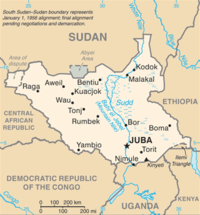 This CIA map uses the provincial borders that existed at the time Sudan gained independence in 1956. In 1960, small sections were transferred to northerly provinces. The Comprehensive Peace Agreement of 2005 ending the second Sudanese civil war provided that the border between southern and northern Sudan would be restored to its 1956 state.
This CIA map uses the provincial borders that existed at the time Sudan gained independence in 1956. In 1960, small sections were transferred to northerly provinces. The Comprehensive Peace Agreement of 2005 ending the second Sudanese civil war provided that the border between southern and northern Sudan would be restored to its 1956 state. Main article: Geography of South Sudan
Main article: Geography of South SudanSouth Sudan lies between latitudes 3° and 13°N, and longitudes 24° and 36°E. It is covered in tropical forest, swamps, and grassland. The White Nile passes through the country, passing by Juba.[39]
Fauna, flora, and mycobiota
South Sudan's protected area of Bandingilo National Park hosts the second-largest wildlife migration in the world. Surveys have revealed that Boma National Park, west of the Ethiopian border, as well as the Sudd wetland and Southern National Park near the border with Congo, provided habitat for large populations of hartebeest, kob, topi, buffalo, elephants, giraffes, and lions. South Sudan's forest reserves also provided habitat for bongo, giant forest hogs, Red River hogs, forest elephants, chimpanzees, and forest monkeys. Surveys begun in 2005 by WCS in partnership with the semi-autonomous government of Southern Sudan revealed that significant, though diminished wildlife populations still exist, and that, astonishingly, the huge migration of 1.3 million antelopes in the southeast is substantially intact.
Habitats in the country include grasslands, high-altitude plateaus and escarpments, wooded and grassy savannas, floodplains, and wetlands. Associated wildlife species include the endemic white-eared kob and Nile Lechwe, as well as elephants, giraffes, common eland, giant eland, oryx, lions, African wild dogs, cape buffalo, and topi (locally called tiang). Little is known about the white-eared kob and tiang, both types of antelope, whose magnificent migrations were legendary before the civil war. The Boma-Jonglei Landscape region encompasses Boma National Park, broad pasturelands and floodplains, Bandingilo National Park, and the Sudd, a vast area of swamp and seasonally-flooded grasslands that includes the Zeraf Wildlife Reserve.
Little is known of the fungi of South Sudan. A list of fungi in Sudan was prepared by S.A.J. Tarr and published by the then Commonwealth Mycological Institute (Kew, Surrey, UK) in 1955. The list, of 383 species in 175 genera, included all fungi observed within the then boundaries of the country. Many of those records relate to what is now South Sudan. Most of the species recorded were associated with diseases of crops. The true number of species of fungi occurring in South Sudan is likely to be much higher. Nothing is known of the conservation status of fungi in South Sudan although, like animals and plants, they are likely to be affected by climate change, pollution, and other threats.
In 2006, President Kiir announced that his government would do everything possible to protect and propagate South Sudanese fauna and flora, and seek to reduce the effects of wildfires, waste dumping, and water pollution. The environment is threatened by the development of the economy and infrastructure.
Several ecoregions extend across South Sudan: the East Sudanian savanna, Northern Congolian forest-savanna mosaic, Saharan flooded grasslands (Sudd), Sahelian Acacia savanna, East African montane forests, and the Northern Acacia-Commiphora bushlands and thickets.[58]
Demographics
Main article: Demographics of South SudanSouth Sudan has a population of around 8 million and a predominantly rural, subsistence economy. This region has been negatively affected by war for all but 10 years of the independence period (1956), resulting in serious neglect, lack of infrastructure development, and major destruction and displacement. More than 2 million people have died, and more than 4 million are internally displaced persons or became refugees as a result of the civil war and war-related impacts. Here the South Sudanese practice mainly indigenous traditional beliefs, although some practice Christianity, as a result of Christian missionary efforts.[18] The south contains many tribal groups and uses many more languages than the north. The major ethnic groups present in South Sudan are the Dinka at more than 1 million (approximately 15 percent combined), the Nuer (approximately ten percent), the Bari, and the Azande. The Shilluk constitute a historically influential state along the White Nile, and their language is fairly closely related to Dinka and Nuer. The traditional territories of the Shilluk and the Northeastern Dinka are adjacent.
Education
Main article: Education in South SudanThe educational system of South Sudan is modelled after that of the Republic of Sudan. Primary education consists of eight years, followed by three years of secondary education, and then four years of university instruction; the 8 + 3 + 4 system, in place since 1990. The primary language at all levels is English, as compared to the Republic of Sudan, where the language of instruction is Arabic.[59] There is a severe shortage of English teachers and English-speaking teachers in the scientific and technical fields.
Languages
Indigenous languages
There are over 60 indigenous languages spoken in South Sudan. Most of the indigenous languages are classified under the Nilo-Saharan language family; collectively, they represent two of the first order divisions of Nilo-Saharan (Eastern Sudanic and Central Sudanic). The remainder belong to the Ubangi languages of the Niger-Congo language family, and they are spoken in the southwest. The most recent available population statistics for many South Sudan indigenous languages go back to the 1980s. Since then, the war of independence led to many civilian deaths and massive displacements of refugees to Sudan and beyond. Due to the drawing of colonial borders Africa by the European invaders in the 19th and 20th centuries, some South Sudan indigenous languages are spoken in neighboring countries also, and some of these languages have even more speakers in the neighboring countries. Zande, for example is estimated to have twice as many speakers in the neighboring Democratic Republic of the Congo, while the Banda group of languages may have more speakers in the Central African Republic than in South Sudan. In South Sudan, the languages with the most speakers are Nuer with 740,000 speakers in 1982 and the Dinka sociolinguistic language or dialect continuum with perhaps 1.4 million in 1986; these two groups of languages are also closely related to one another. Bari had 420,000 in 2000, and Zande had 350,000 in 1982. Of the Ubangi languages, available figures indicate that Zande is the only one with a substantial number of speakers in South Sudan.[60]
Nonindigenous languages
In the state of Western Bahr Al Ghazal, in its border region with the neighboring country of Sudan, there is an indeterminate number of Baggara Arabs—a traditionally nomadic people—that resides either seasonally or permanently. Their language is Chadian Arabic and their traditional territories are in the southern portions of the Sudanese regions of Kordofan and Darfur. In the capital, Juba, there are several thousand people who use an Arabic pidgin, Juba Arabic.[61][62] Since South Sudan was long a part of Sudan for a century, some South Sudanese are conversant in either Sudanese Arabic or Modern Standard Arabic, the latter being the native spoken language of Arabs and Arabized peoples in Sudan.
The official language of South Sudan is English.[1]
South Sudan's ambassador to Kenya said on 2 August 2011 that Swahili will be introduced in South Sudan with the goal of supplanting Arabic as a lingua franca, in keeping with the country's intention of orientation toward the East African Community rather than Sudan and the Arab League.[63]
A group of South Sudanese refugees who were raised in Cuba during the Sudanese wars, numbering about 600, also speak fluent Spanish. They have been named the Cubanos, and most had settled in Juba by the time of the country's independence.[64]
Population
2008 census
The "Fifth Population and Housing Census of Sudan", of Sudan as a whole, was conducted in April 2008. However the census results of Southern Sudan were rejected by Southern Sudanese officials as reportedly "the central bureau of statistics in Khartoum refused to share the national Sudan census raw data with southern Sudan centre for census, statistic and evaluation."[65] The census showed the Southern Sudan population to be 8.26 million,[4][66] however President Kiir had "suspected figures were being deflated in some regions and inflated in others, and that made the final tally 'unacceptable'."[67] He also claimed the Southern Sudanese population to really be one-third of Sudan, while the census showed it to be only 22%.[66] Many Southern Sudanese were also said to not have been counted "due to bad weather, poor communication and transport networks, and some areas were unreachable, while many Southern Sudanese remained in exile in neighbouring countries, leading to 'unacceptable results', according [to] southern Sudanese authorities."[67] The chief American technical adviser for the census in the South said the census-takers probably reached 89% of the population.[68]
2009 census
In 2009, Sudan started a new Southern Sudanese census ahead of the 2011 independence referendum, which is said to also include the Southern Sudanese diaspora. However this initiative was criticised as it was to leave out countries with a high share of the Southern Sudanese diaspora, and rather count countries where the diaspora share was low.[69]
Religion
Main article: Religion in South SudanSee also: Islam in South SudanReligions followed by the South Sudanese include traditional indigenous religions, Christianity and Islam.[70] The last census to mention the religion of southerners dates back to 1956 where a majority followed traditional beliefs while the rest were classified as either Christian or Muslim.[71] Scholarly[72][73][74] and U.S. Department of State sources[18] state that a majority of southern Sudanese maintain traditional indigenous (sometimes referred to as Animist) beliefs with those following Christianity in a minority (albeit an influential one). According to the Federal Research Division of the US Library of Congress: "in the early 1990s possibly no more than 10 percent of southern Sudan's population was Christian".[75] In the early 1990s, official records of Sudan claimed that from population of what then included South Sudan, 25% of people followed traditional religions and 5% were Christians.[76] However, some news reports claim a Christian majority,[77][78] and the US Episcopal Church claims the existence of large numbers of Anglican adherents from the Episcopal Church of the Sudan: 2 million members in 2005.[79] Likewise, according to the World Christian Encyclopedia, the Catholic Church is the largest single Christian body in Sudan since 1995, with 2.7 million Catholics mainly concentrated in South Sudan.[80]
Speaking at Saint Theresa Cathedral in Juba, South Sudanese President Kiir, a Roman Catholic, stated that South Sudan would be a nation which respects the freedom of religion.[81] Amongst Christians, most are Catholic and Anglican, though other denominations are also active, and animist beliefs are often blended with Christian beliefs.[82]
Culture
Main article: Culture of South SudanGames and sports
 South Sudanese Basketball player Luol Deng.
South Sudanese Basketball player Luol Deng.
Many traditional and modern games and sports are popular in South Sudan, particularly wrestling and mock battles. The traditional sports were mainly played after the harvest seasons to celebrate the harvests and finish the farming seasons. The wrestlers were generally strong, well-trained young men. During the matches, they smeared themselves with ochre – perhaps to enhance the grip or heighten their perception. The matches attracted large numbers of spectators who sang, played drums and danced in support of their favourite wrestlers. Though these were perceived as competition, they were primarily for entertainment.[83]
In the modern era, South Sudanese have excelled in international sports. Luol Deng is a basketball star with the Chicago Bulls in the National Basketball Association. Other leading international basketball players from South Sudan include Manute Bol, Ajou Deng, Kueth Duany, Deng Gai and Ater Majok. The South Sudan national basketball team played its first match against Uganda national basketball team on 10 July 2011 in Juba.[84]
Association football is also becoming popular in South Sudan, and there are many initiatives by the Government of South Sudan and other partners to promote the sport and improve the level of play. One of these initiatives is South Sudan Youth Sports Association (SSYSA). SSYSA is already holding soccer clinics in Konyokonyo and Muniki areas of Juba in which young boys are coached. In recognition of these efforts with youth soccer, the country recently hosted the CECAFA youth soccer competitions. Barely a month earlier, it had also hosted the larger East African Schools Sports tournaments. The South Sudan national association football team was formed in May 2011, although it does not have membership of FIFA.[85] The team played its first match against Tusker FC of the Kenyan Premier League on 10 July 2011 in Juba,[84] scoring early but losing 1–3 to the more experienced team. According to Salih Samuel, the football team's coach, South Sudan is preparing to apply to join the Confederation of African Football, a branch of FIFA.[86]
Economy
Main article: Economy of South SudanThe economy of South Sudan is one of the world's weakest and most underdeveloped with South Sudan having little existing infrastructure and the highest maternal mortality and female illiteracy rates in the world as of 2011.[87] South Sudan exports timber to the international market. The region also contains many natural resources such as petroleum, iron ore, copper, chromium ore, zinc, tungsten, mica, silver, gold, and hydropower. The country's economy, as in many other developing countries, is heavily dependent on agriculture.
Oil
The oilfields in the South have kept the region's economy alive since 1999. However, after South Sudan became an independent nation in July 2011, southern and northern negotiators were not immediately able to reach an agreement on how to split the revenue from these southern oilfields.[88] It is estimated that around 80% of the untapped oil deposit in Sudan is in South Sudan. The oil revenues according to the Comprehensive Peace Agreement (CPA), were split equally for the duration of the agreement period.[89] Since South Sudan relies on pipelines, refineries, and Port Sudan's facilities in Red Sea state in Sudan, the agreement stated that the government of Sudan in Khartoum would receive 50% share of all oil revenues.[89][90] This arrangement was maintained during the second period of autonomy from 2005 to 2011. A similar arrangement is likely to continue during the independence era of South Sudan, with northern negotiators reportedly pressing for a deal maintaining the 50–50 split of oil revenues and the South Sudanese holding out for more favorable terms.[91] Oil revenues constitute more than 98% of the government of South Sudan's budget according to the southern government's Ministry of Finance and Economic Planning and this has amounted to more than $8 billion in revenue since the signing of the peace agreement.[89]
Transport
Main article: Transport in South SudanRailway
Main article: Rail transport in South SudanSouth Sudan has 248 km (154 mi) of single-track 1,067 mm (3 ft 6 in) narrow gauge railway line from the Sudanese border to Wau terminus. There are proposed extensions from Wau to Juba. There are also plans to link Juba with the Kenyan and Ugandan railway networks.
Air
Main article: List of airports in South SudanThe busiest and most developed airport in South Sudan is Juba Airport, which has regular international connections to Entebbe, Nairobi, Cairo, Addis Ababa, and Khartoum. Juba Airport is also the home base of Feeder Airlines Company and Southern Star Airlines.[92] Other international airports include Malakal, with international flights to Addis Ababa and Khartoum; Wau, with weekly service to Khartoum; and Rumbek, also with weekly flights to Khartoum. Southern Sudan Airlines also serves Nimule and Akobo, the airstrips of which are unpaved. There are several smaller airports throughout South Sudan, the majority of which consist of little more than dirt airstrips.
Humanitarian situation
South Sudan is acknowledged to have some of the worst health indicators in the world.[16][93][94] The under-five infant mortality rate is 135.3 per 1,000, whilst maternal mortality is the highest in the world at 2,053.9 per 100,000 live births.[94] In 2004, there were only three surgeons serving southern Sudan, with three proper hospitals, and in some areas there was just one doctor for every 500,000 people.[16]
The epidemiology of HIV/AIDS in the South Sudan is poorly documented but the prevalence is thought to be around 3.1%.[95]
At the time of the Comprehensive Peace Agreement of 2005, humanitarian needs in Southern Sudan were massive. However, humanitarian organizations under the leadership of the UN Office for the Coordination of Humanitarian Affairs (OCHA) managed to ensure sufficient funding to bring relief to the local populations. Along with recovery and development aid, humanitarian projects were included in the 2007 Work Plan of the United Nations and partners. More than 90% of the population of South Sudan live on less than $1 a day, despite the GDP per capita of the entirety of Sudan being $1200 ($3.29/day).[96]
In 2007, the United Nations Office for the Coordination of Humanitarian Affairs (under the leadership of Éliane Duthoit) decreased its involvement in Southern Sudan, as humanitarian needs gradually diminished, slowly but markedly turning over control to the recovery and development activities of NGOs and community-based organisations.[97]
Famine reportedly led to deaths in Northern Bahr el Ghazal and Warrap states in mid-2011, though the state governments of both denied hunger there was severe enough to cause fatalities.[98]
See also
- Cabinet of South Sudan
- International recognition of South Sudan
- Autonomous Government of Southern Sudan, the autonomous government that existed between 2005 and 2011.
- Southern Sudan Autonomous Region, the autonomous government that existed between 1972 and 1983.
- Lost Boys of Sudan
References
- ^ a b "The Transitional Constitution of the Republic of South Sudan, 2011". Government of South Sudan. http://www.goss-online.org/magnoliaPublic/en/home/mainColumnParagraphs/0/content_files/file/FINAL%20TCRSS.doc. Retrieved 12 July 2011. Part One, 6(2). "English shall be the official working language in the Republic of South Sudan".
- ^ "At a Glance". Official portal. Government of Southern Sudan. 12 July 2011. http://www.goss-online.org/magnoliaPublic/en/about/ataglance.html. Retrieved 2011-07-24.
- ^ "The Transitional Constitution of the Republic of South Sudan, 2011". Government of South Sudan. http://www.goss-online.org/magnoliaPublic/en/home/mainColumnParagraphs/0/content_files/file/FINAL%20TCRSS.doc. Retrieved 15 July 2011. Part One, 6(1). "All indigenous languages of South Sudan are national languages".
- ^ a b "Discontent over Sudan census". News24.com. AFP. 21 May 2009. http://www.news24.com/Content/World/News/1073/b52cc36803164f39be83598566f1eb70/21-05-2009-07-23/Discontent_over_Sudan_census. Retrieved 2011-07-14.
- ^ a b South Sudan National Bureau of Statistics (NBS) "Release of first Gross Domestic Product (GDP) and Gross National Income (GNI) figures for South Sudan by the NBS" 11 August 2011 Retrieved 2011-09-05
- ^ ".ss Domain Delegation Data". Internet Assigned Numbers Authority. ICANN. http://www.iana.org/domains/root/db/ss.html. Retrieved 2011-09-01.
- ^ "New country, new number: Country code 211 officially assigned to South Sudan" (Press release). International Telecommunication Union. 14 July 2011. http://www.itu.int/net/pressoffice/press_releases/2011/25.aspx. Retrieved 2011-07-20.
- ^ a b c d "South Sudan". The World Factbook. CIA. 11 July 2011. https://www.cia.gov/library/publications/the-world-factbook/geos/od.html. Retrieved 2011-07-14.
- ^ UN classification of world regions "UN classification of world regions". UN. http://unstats.un.org/unsd/methods/m49/m49regin.htm UN classification of world regions. Retrieved 25 September 2011.
- ^ "South Sudan profile". BBC. 5 July 2011. http://www.bbc.co.uk/news/world-africa-14019208. Retrieved 24 July 2011.
- ^ Broadcast of Declaration of Independence (part 1)
- ^ Broadcast of Declaration of Independence (part 2)
- ^ Worsnip, Patrick (14 July 2011). "South Sudan admitted to U.N. as 193rd member". Reuters. http://uk.reuters.com/article/2011/07/14/uk-sudan-un-membership-idUKTRE76D3I120110714. Retrieved 2011-07-24.
- ^ "UN welcomes South Sudan as 193rd Member State". United Nations News Service. 14 July 2011. http://www.un.org/apps/news/story.asp?NewsID=39034&Cr=South+Sudan&Cr1=. Retrieved 14 July 2011.
- ^ a b "South Sudan Becomes African Union's 54th Member". Voice of America News. 28 July 2011. http://www.voanews.com/english/news/africa/east/South-Sudan-Becomes-African-Unions-54th-Member-126320433.html. Retrieved 28 July 2011.
- ^ a b c Ross, Emma (28 January 2004). Southern Sudan has unique combination of worst diseases in the world. Sudan Tribune.
- ^ Helen Chapin Metz, ed (1991). "The Turkiyah, 1821-85". Sudan: A Country Study. Area handbook series. Washington, D.C.: GPO for the Library of Congress. ISBN 084440750X. http://countrystudies.us/sudan/11.htm.
- ^ a b c d "Background Note: Sudan" U.S. Department of State 9 November 2010 Retrieved 8 December 2010
- ^ Fick, Maggie (30 January 2011). "Over 99 pct in Southern Sudan vote for secession". USA Today. http://www.usatoday.com/news/topstories/2011-01-30-2052877353_x.htm. Retrieved 30 January 2011.
- ^ Karimi, Faith (22 January 2011). "Report: Vote for Southern Sudan independence nearly unanimous". CNN. http://articles.cnn.com/2011-01-22/world/sudan.referendum.results_1_preliminary-results-official-results-election-officials?_s=PM:WORLD. Retrieved 2 April 2011.
- ^ News, BBC (30 January 2011). "99.57% of Southern Sudanese vote yes to independence". BBC News. http://www.bbc.co.uk/news/world-africa-12317927. Retrieved 30 January 2011.
- ^ Human Rights Watch, 2009.
- ^ a b "South Sudan army kills fighters in clashes". Al Jazeera English. 24 April 2011. http://english.aljazeera.net/news/africa/2011/04/2011424145446998235.html. Retrieved 26 April 2011.
- ^ "Civilians dead in South Sudan battle". Associated Press. http://www.google.com/hostednews/ap/article/ALeqM5iGjG9whhCv3fK2pUQK5m9HkvOFig?docId=8760bf3cf28f4230838f7a530d928a4e. Retrieved 8 June 2011.
- ^ "The Transitional Constitution of the Republic of South Sudan, 2011". Government of South Sudan. http://www.goss-online.org/magnoliaPublic/en/home/mainColumnParagraphs/0/content_files/file/FINAL%20TCRSS.doc. Retrieved 12 July 2011.
- ^ "South Sudan passes interim constitution amid concerns over presidential powers". Sudan Tribune. 8 July 2011. http://www.sudantribune.com/South-Sudan-passes-interim,39457. Retrieved 2011-07-24.
- ^ "Interim Constitution of Southern Sudan of 2005". http://gurtong.brandx.eu/LinkClick.aspx?fileticket=1atewJwi6UU%3d&tabid=341.
- ^ BBC News Africa 5 Jan. 2011[vague]
- ^ "Juba parliament authorizes establishment of South Sudan air force". Sudan Tribune. 25 June 2008. http://www.sudantribune.com/spip.php?article27642. Retrieved 2011-07-24.
- ^ "Creation of the South Sudan Air Force". http://aircraft.zurf.info/article/creation-south-sudan-air-force. Retrieved 9 January 2011.
- ^ a b c Davies and Smith 2010. Planning and budgeting in Southern Sudan: starting from scratch. London: Overseas Development Institute
- ^ "New capital city for South Sudan?". Radio Netherlands. 6 February 2011. http://www.rnw.nl/africa/article/new-capital-city-south-sudan. Retrieved 24 July 2011.
- ^ "South Sudan to establish a new capital city and relocate from Juba after independence". Sudan Tribune. 6 February 2011. http://www.sudantribune.com/South-Sudan-to-establish-a-new,37886. Retrieved 24 July 2011.
- ^ a b "South Sudan relocates its capital from Juba to Ramciel". Sudan Tribune. 3 September 2011. http://www.sudantribune.com/South-Sudan-relocates-its-capital,40027. Retrieved 3 September 2011.
- ^ Amos, Mashel (29 April 2011). "The search for new nation’s capital in South Sudan". The Independent. http://www.independent.co.ug/News/regional-news/4130-the-search-for-new-nations-capital-in-south-sudan. Retrieved 24 July 2011.
- ^ "Lakes Leaders Visit Prospective South Sudanese Capital". Gurtong. 15 February 2011. http://www.gurtong.net/ECM/Editorial/tabid/124/ctl/ArticleView/mid/519/articleId/4879/Lakes-Leaders-Visit-Prospective-South-Sudanese-Capital.aspx. Retrieved 24 July 2011.
- ^ Carlstrom, Gregg (12 July 2011). "South Sudan journalists facing intimidation". Al Jazeera English. http://english.aljazeera.net/indepth/spotlight/southsudanindependence/2011/07/201171211357184117.html. Retrieved 12 July 2011.
- ^ "South Sudan security detains two journalists". Committee to Protect Journalists. 7 November 2011. http://www.cpj.org/2011/11/south-sudan-security-detains-two-journalists.php. Retrieved 8 November 2011.
- ^ a b Will Ross (9 January 2011). "Southern Sudan votes on independence". BBC. http://www.bbc.co.uk/news/world-africa-12144675. Retrieved 2 April 2011.
- ^ "South Sudan becomes an independent nation". BBC News. 9 July 2011. http://www.bbc.co.uk/news/world-africa-14089843. Retrieved 9 July 2011.
- ^ AlAhram Weekly - Heading for headwaters
- ^ Netanyahu: Israel recognizes South Sudan as independent state
- ^ "UN welcomes South Sudan as 193rd member". BBC News. 14 July 2011. http://www.bbc.co.uk/news/world-africa-14151390. Retrieved 14 July 2011.
- ^ "The Peace and Security Council of the African Union (AU), at its 285th meeting held on 13 July 2011, was briefed by the Commissioner for Peace and Security on the accession to independence of the Republic of South Sudan". African Union. 13 July 2011. http://www.au.int/en/content/peace-and-security-council-african-union-au-its-285th-meeting-held-13-july-2011-was-briefe-1. Retrieved 15 July 2011.
- ^ "COMESA Welcomes New Member". MENAFN.com. 31 October 2011. http://www.menafn.com/qn_news_story.asp?storyid={62d78860-a792-475c-bff9-0722d5d61d3e}. Retrieved 13 November 2011.
- ^ "South Sudan Launches Bid to Join Commonwealth". Talk of Sudan. 8 July 2011. http://talkofsudan.com/sudan/item/9001-south-sudan-launches-bid-to-join-commonwealth. Retrieved 9 July 2011.
- ^ "South Sudan: Big trading potential for EAC". IGIHE. 8 July 2011. http://en.igihe.com/spip.php?article455. Retrieved 9 July 2011.
- ^ "Welcome South Sudan to EAC!". East African Business Week. 10 July 2011. http://www.busiweek.com/11/editorial/editorial/1316-welcome-south-sudan-to-eac. Retrieved 10 July 2011.
- ^ "South Sudan avails new foreign policy, to open 54 embassies". Sudan Tribune. 25 July 2011. http://www.sudantribune.com/South-Sudan-avails-new-foreign,39637. Retrieved 6 August 2011.
- ^ "IMF Receives Membership Application from South Sudan, Seeks Contributions to Technical Assistance Trust Fund to Help New Country". International Monetary Fund. 20 April 2011. http://www.imf.org/external/np/sec/pr/2011/pr11145.htm. Retrieved 10 July 2011.
- ^ "World Bank Group Congratulates People of South Sudan on Independence". The Financial. 9 July 2011. http://finchannel.com/news_flash/World/90526_World_Bank_Group_Congratulates_People_of_South_Sudan_on_Independence/. Retrieved 10 July 2011.
- ^ "South Sudan "entitled to join Arab League"". Sudan Tribune. 12 June 2011. http://www.sudantribune.com/South-Sudan-entitled-to-join-Arab,39193. Retrieved 8 July 2011.
- ^ El-Husseini, Asmaa (7 July 2011). "Hoping for the best". Al-Ahram. http://weekly.ahram.org.eg/2011/1055/re10.htm. Retrieved 8 July 2011.
- ^ http://www.gossmission.org/goss/index.php?option=com_content&task=view&id=1263&Itemid=1
- ^ "Republic of South Sudan: Opportunities and Challenges for Africa’s Newest Country". Journalist's Resource.org. http://journalistsresource.org/studies/government/international/south-sudan-op…newest-country/.
- ^ a b c d e "Sudan: Transcending tribe". Al Jazeera English. http://english.aljazeera.net/photo_galleries/africa/201111010324526960.html. Retrieved 30 April 2011.
- ^ "SPLA set fire to over 7,000 homes in Unity says Mayom county official". Sudan Tribune. 24 May 2011. http://www.sudantribune.com/SPLA-set-fire-to-over-7-000-homes,39010. Retrieved 9 July 2011.
- ^ Burgess, Neil, Jennifer D'Amico Hales, Emma Underwood (2004). Terrestrial Ecoregions of Africa and Madagascar: A Conservation Assessment. Island Press, Washington DC.
- ^ In 2007 South Sudan Adopted English As the Official Language of Communication
- ^ Ethnologue, Sudan
- ^ Tosco, Mauro (1995). "A Pidgin Verbal System: The Case of Juba Arabic". Anthropological linguistics 37 (4): 423–459.
- ^ Arabic dialectology specialist Alan S. Kaye, considers it partially decreolized.[citation needed] Ethnologue has a contrarian judgement that Juba Arabic is a creole.
- ^ "South Sudanese still in Kenya despite new state". Coastweek. 5 August 2011. http://www.coastweek.com/kenxin_110805_04.htm. Retrieved 6 August 2011.
- ^ Radio France International, "Los cubanos, la élite de Sudán del Sur". Retrieved 11 July 2011
- ^ "South Sudan parliament throw outs census results". SudanTribune. 8 July 2009. http://www.sudantribune.com/spip.php?article31746.
- ^ a b Fick, Maggie (8 June 2009). "S. Sudan Census Bureau Releases Official Results Amidst Ongoing Census Controversy". !enough The project to end genocide and crimes against humanity. http://www.enoughproject.org/blogs/s-sudan-census-bureau-releases-official-results-amidst-ongoing-census-controversy.
- ^ a b Birungi, Marvis (10 May 2009). "South Sudanese officials decry 'unfortunate' announcement of census results". The New Sudan Vision. http://www.newsudanvision.com/index.php?option=com_content&view=article&id=1677:southern-sudanese-officials-decry-unfortunate-announcement-of-census-results&catid=1:sudan-news-stories&Itemid=6.
- ^ Thompkins, Gwen (15 April 2009). "Ethnic Divisions Complicate Sudan's Census". NPR. http://www.npr.org/templates/story/story.php?storyId=103124761.
- ^ "South Sudan says Northern Sudan's census dishonest". Radio Nederland Wereldomroep. 6 November 2009. http://www.rnw.nl/africa/article/south-sudan-claims-northern-sudans-census-dishonest.
- ^ "South Sudan profile". BBC News. 8 July 2011. http://www.bbc.co.uk/news/world-africa-14069082. Retrieved 9 July 2011.
- ^ "South Sudan's Muslims welcome secession". Agence France-Presse. http://www.thedailystar.net/newDesign/news-details.php?nid=169306. Retrieved 2011-08-15.
- ^ Kaufmann, E.P. Rethinking ethnicity: majority groups and dominant minorities. Routledge, 2004, p. 45.
- ^ Minahan, J. Encyclopedia of the Stateless Nations: S-Z. Greenwood Press, 2002, p. 1786.
- ^ Arnold, G. Book Review: Douglas H. Johnson, The Root Causes of Sudan's Civil Wars. African Journal of Political Science Vol.8 No. 1, 2003, p. 147.
- ^ Sudan: A Country Study Federal Research Division, Library of Congress – Chapter 2, Ethnicity, Regionalism and Ethnicity
- ^ Geographica. The Complete Illustrated Atlas of the world, 1999, p. 336
- ^ "More than 100 dead in south Sudan attack-officials" SABC News 21 September 2009 Retrieved 5 April 2011
- ^ Hurd, Emma "Southern Sudan Votes To Split From North" Sky News 8 February 2011 Retrieved 5 April 2011
- ^ "How many Anglicans are there in the Anglican Church in North America?"
- ^ World Christian Encyclopedia, eds. David Barrett, Geo. Kurian, Todd Johnson (Oxford: Oxford Univeristy Press, 2001), pp 699, 700
- ^ "South Sudan To Respect Freedom Of Religion Says GOSS President | Sudan Radio Service". Sudanradio.org. 21 February 2011. http://www.sudanradio.org/south-sudan-respect-freedom-religion-says-goss-president. Retrieved 9 July 2011.
- ^ Christianity, in A Country Study: Sudan, U.S. Library of Congress.
- ^ DiPiazza, Francesca (2006). Sudan in Pictures. Twenty-First Century Books. p. 54. ISBN 0-8225-2678-6. Online version available at Google Books
- ^ a b World's newest nation set to step into sporting area – The Jakarta Globe. Written by Peter Martell. Published 6 July 2011. Retrieved 9 July 2011.
- ^ Constitution, Budget for National soccer team remains unfinished – The Juba Post. Written by Kayanga John. Published ??? Retrieved 9 July 2011.
- ^ "S. Sudan team kicks off to a good start, then collapses". SKNVibes. 10 July 2011. http://www.sknvibes.com/news/newsdetails.cfm/33538. Retrieved 10 July 2011.
- ^ Elbagir, Nima; Karimi, Faith (9 July 2011). "South Sudanese celebrate the birth of their nation". CNN. http://edition.cnn.com/2011/WORLD/africa/07/09/sudan.new.nation/index.html. Retrieved 9 July 2011.
- ^ Gettleman, Jeffrey (9 July 2011). "After Years of Struggle, South Sudan Becomes a New Nation". New York Times. http://www.nytimes.com/2011/07/10/world/africa/10sudan.html?_r=1&hp=&adxnnl=1&pagewanted=2&adxnnlx=1310234502-5nvX4GUBg0fK28Wp4PYaEA.
- ^ a b c Hamilton, Rebecca "Awaiting Independence Vote, Southern Sudan Has High Hopes", Washington Post, 28 November 2010, via Pulitzer Center on Crisis Reporting.
- ^ Oil-Rich South Sudan Vincent Trivett; Published by businessinsider
- ^ Trivett, Vincent (8 July 2011). "Oil-Rich South Sudan Has Hours To Choose Between North Sudan, China And The U.S.". Business Insider. http://www.businessinsider.com/southern-sudan-independence-2011-7. Retrieved 9 July 2011.
- ^ South Sudan gets new airline
- ^ Moszynski, Peter (23 July 2005). Conference plans rebuilding of South Sudan's health service. BMJ.
- ^ a b "South Sudan Household Survey". South Sudan Medical Journal. December 2007. http://www.southernsudanmedicaljournal.com/assets/files/misc/SHHS.pdf.
- ^ Hakim, James (August 2009). "HIV/AIDS: an update on Epidemiology, Prevention and Treatment". South Sudan Medical Journal. http://www.southernsudanmedicaljournal.com/archive/2009-08/untitled-resource.html.
- ^ Ambler, Sean (10 January 2011). "Support freedom for Southern Sudan and fight for workers' unity against imperialism". League for the Fifth International. http://fifthinternational.org/content/support-freedom-southern-sudan-and-fight-workers-unity-against-imperialism. Retrieved 2011-07-24.
- ^ "SUDAN: Peace bolsters food security in the south". IRIN. 18 April 2007. http://www.irinnews.org/Report.aspx?ReportId=71676. Retrieved 2011-07-24.
- ^ "South Sudan’s N. Bahr el Ghazal denies reports that hunger caused death". Sudan Tribune. 17 August 2011. http://www.sudantribune.com/South-Sudan-s-N-Bahr-el-Ghazal,39863. Retrieved 18 August 2011.
Further reading
- Biel, Melha Rout (2007). South Sudan after the Comprehensive Peace Agreement. Jena: Netzbandt Verlag. ISBN 9783937884011.
- Tvedt, Terje (2004). South Sudan. An Annotated Bibliography. (2 vols) (2nd ed.). London/New York: IB Tauris. ISBN 1-860-64987-4.
- "Profile: Southern Sudan leader Salva Kiir". BBC Online. 5 January 2011. http://www.bbc.co.uk/news/world-africa-12107760. Retrieved 2011-07-24.
- No One to Intervene: Gaps in Civilian Protection in Southern Sudan. New York: Human Rights Watch. June 2009. http://www.humansecuritygateway.com/documents/HRW_GapsCivlianProtection_SouthernSudan.pdf.
External links
Government
- Government of South Sudan
- Government of South Sudan – USA and UN Mission
- Government of South Sudan – UK Mission
- Southern Sudan Legislative Assembly
- South Sudan entry at The World Factbook
 South Sudan topics
South Sudan topicsHistory Addis Ababa Agreement (1972) · Anyanya · First Sudanese Civil War • Second Sudanese Civil War • South Kordofan conflict • Government of Southern Sudan (1972–1983) • Government of Southern Sudan (2005–2011) • Comprehensive Peace Agreement • 2011 Independence referendum • 2011 South Sudan clashesEconomy Transport · Airports · Communications · Companies · BanksPolitics Constitution • President • Vice-President • Legislative Assembly • 2010 General election • Foreign relations · International recognition · MilitaryGeography
DemographicsSubdivisions • Languages · Religion · Ethnic groups · Education · Human rights · Health · Cities · RiversCulture Art · Literature · Media · Music · Sport (South Sudan Football Association) • South Sudan Oyee! · Flag · Coat of armsCategories:- South Sudan
- African countries
- East Africa
- English-speaking countries and territories
- Federal countries
- Federal republics
- Former British colonies
- Least developed countries
- States and territories established in 2011
- Member states of the United Nations
- Member states of the African Union
Wikimedia Foundation. 2010.

